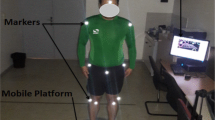Abstract
The present study proposes a new approach for the assessment of the human balance control. This approach is based on the decomposition of the center of pressure displacement using empirical mode decomposition (EMD) that provides an effective time-frequency analysis of non-stationary signals. Twenty-eight healthy subjects performed quiet standing in four conditions—feet apart/together with respect to eyes open/closed—while recording the stabilometric signals in the anteroposterior (AP) and mediolateral (ML) directions. The EMD method decomposes each stabilometric signal into several subsignals called intrinsic mode functions (IMFs). Stabilogram-diffusion analysis technique is applied to generate the diffusion curve of each IMF signal. Each diffusion curve is modeled as a second-order system and provides representative features, such as the gain parameter. Analysis of the gain parameter shows the major effect of visual input and feet conditions on the strategy to control/stabilize the balance. Significant differences were found between young and elderly, and between women and men. In addition, the impact of feet position seems to be higher in ML direction than in AP direction.






Similar content being viewed by others
References
Spoor, F., Garland, T., Krovitz, G., Ryan, T.M., Silcox, M.T., Walker, A.: The primate semicircular canal system and locomotion. Proc. Nat. Acad. Sci. 104(26), 10808–10812 (2007)
Hertel, J., Olmsted-Kramer, L.C.: Deficits in time-to-boundary measures of postural control with chronic ankle instability. Gait Posture 25(1), 33–39 (2007)
Horak, F.B.: Postural orientation and equilibrium: what do we need to know about neural control of balance to prevent falls? Age Ageing 35(suppl 2), ii7–ii11 (2006)
Chiari, L., Rocchi, L., Cappello, A.: Stabilometric parameters are affected by anthropometry and foot placement. Clin. Biomech. 17(9), 666–677 (2002)
Redfern, M.S., Yardley, L., Bronstein, A.M.: Visual influences on balance. J. Anxiety Disord. 15(1), 81–94 (2001)
Granacher, U., Bridenbaugh, S.A., Muehlbauer, T., AnjaWehrle, Kressig, R.W.: Age-related effects on postural control under multi-task conditions. Gerontology 57(3), 247–255 (2010)
Callisaya, M.L., Blizzard, L., Schmidt, M.D., McGinley, J.L., Srikanth, V.K.: Ageing and gait variability—a population-based study of older people. Age Ageing 39, 191–197 (2010)
Khasnis, A., Gokula, R.M., et al.: Rombergs test. J. Postgrad. Med. 49(2), 169 (2003)
Carneiro, J.A.O., Santos-Pontelli, T.E.G., Colafêmina, J.F., Carneiro, A.A.O., Ferriolli, E.: Analysis of static postural balance using a 3d electromagnetic system. Braz. J. Otorhinolaryngol. 76(6), 783–788 (2010)
Winter, D.A.: Human balance and posture control during standing and walking. Gait Posture 3(4), 193–214 (1995)
Gabell, A., Simons, M.A., Nayak, U.S.L.: Falls in the healthy elderly: predisposing causes. Ergonomics 28(7), 965–975 (1985)
Prudham, D., Grimley Evans, J.: Factors associated with falls in the elderly: a community study. Age Ageing 10(3), 141–146 (1981)
Zok, M., Mazza, C., Cappozzo, A.: Should the instructions issued to the subject in traditional static posturography be standardised? Med. Eng. Phys. 30(7), 913–916 (2008)
McIlroy, W.E., Maki, B.E.: Preferred placement of the feet during quiet stance: development of a standardized foot placement for balance testing. Clin. Biomech. 12(1), 66–70 (1997)
Carpenter, M.G., Frank, J.S., Winter, D.A., Peysar, G.W.: Sampling duration effects on centre of pressure summary measures. Gait Posture 13(1), 35–40 (2001)
Raymakers, J.A., Samson, M.M., Verhaar, H.J.J.: The assessment of body sway and the choice of the stability parameter(s). Gait Posture 21(1), 48–58 (2005)
Prieto, T.E., Myklebust, J.B., Hoffmann, R.G., Lovett, E.G., Myklebust, B.M.: Measures of postural steadiness: differences between healthy young and elderly adults. IEEE Trans. Biomed. Eng. 43(9), 956–966 (1996)
Huang, N.E., Shen, Z., Long, S.R., Wu, M.C., Shih, H.H., Zheng, Q., Yen, N.-C., Tung, C.C., Liu, H.H. (1998) The empirical mode decomposition and the Hilbert spectrum for nonlinear and non-stationary time series analysis. In: Proceedings of the Royal Society of London A: Mathematical, Physical and Engineering Sciences, vol. 454, pp. 903–995. The Royal Society, London (1998)
Niang, O., Delechelle, E., Lemoine, J.: A spectral approach for sifting process in empirical mode decomposition. IEEE Trans. Signal Process. 58(11), 5612–5623 (2010)
Nunes, J.-C., Delechelle, E.: Empirical mode decomposition: applications on signal and image processing. Adv. Adapt. Data Anal. 1(01), 125–175 (2009)
Liang, H., Lin, Q.-H., Chen, J.D.Z.: Application of the empirical mode decomposition to the analysis of esophageal manometric data in gastroesophageal reflux disease. IEEE Trans. Biomed. Eng. 52(10), 1692–1701 (2005)
Blanco-Velasco, M., Weng, B., Barner, K.E.: Ecg signal denoising and baseline wander correction based on the empirical mode decomposition. Comput. Biol. Med. 38(1), 1–13 (2008)
Li, S., Zhou, W., Yuan, Q., Geng, S., Cai, D.: Feature extraction and recognition of ictal EEG using EMD and SVM. Comput. Biol. Med. 43(7), 807–816 (2013)
Guo, J., Qin, S., Zhu, C.: The application of energy operator demodulation approach based on emd in mechanical system identification. In 2012 19th International Conference on Mechatronics and Machine Vision in Practice (M2VIP), pp. 80–85. IEEE (2012)
Meng, H., Liang, H.: Search for information-bearing components in neural data. PLoS ONE 9(6), e99793 (2014)
Meng, H., Liang, H.: Intrinsic mode entropy based on multivariate empirical mode decomposition and its application to neural data analysis. Cogn. Neurodyn. 5(3), 277–284 (2011)
Liang, H., Bressler, S.L., Desimone, R., Fries, P.: Empirical mode decomposition: a method for analyzing neural data. Neurocomputing 65, 801–807 (2005)
Wu, Z., Huang, N.E.: Ensemble empirical mode decomposition: a noise-assisted data analysis method. Adv. Adapt. Data Anal. 1(01), 1–41 (2009)
Enriquez, N.: A simple construction of the fractional brownian motion. Stoch. Process. Appl. 109(2), 203–223 (2004)
Mandelbrot, B.B., Van Ness, J.W.: Fractional brownian motions, fractional noises and applications. SIAM Rev. 10(4), 422–437 (1968)
Collins, J.J., De Luca, C.J.: Open-loop and closed-loop control of posture: a random-walk analysis of center-of-pressure trajectories. Exp. Brain Res. 95(2), 308–318 (1993)
Collins, J.J., De Luca, C.J.: Random walking during quiet standing. Phys. Rev. Lett. 73(5), 764 (1994)
James, J., Collins, J.J., De Luca, C.J.: The effects of visual input on open-loop and closed-loop postural control mechanisms. Exp. Brain Res. 103(1), 151–163 (1995)
Author information
Authors and Affiliations
Corresponding author
Rights and permissions
About this article
Cite this article
Safi, K., Mohammed, S., Albertsen, I.M. et al. Automatic analysis of human posture equilibrium using empirical mode decomposition. SIViP 11, 1081–1088 (2017). https://doi.org/10.1007/s11760-017-1061-3
Received:
Revised:
Accepted:
Published:
Issue Date:
DOI: https://doi.org/10.1007/s11760-017-1061-3




